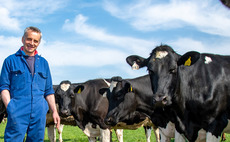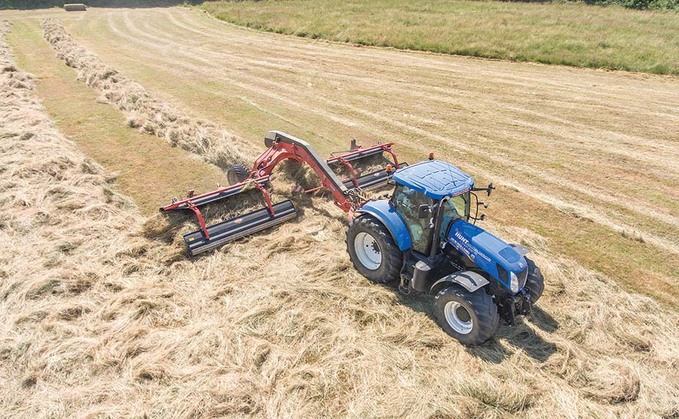
The last time we visited Gloucestershire contractor David Hunt, he was getting to grips with a Kuhn Merge Maxx 950 to improve forage quality. So did it live up to expectations? Geoff Ashcroft reports.
Based in the Cotswolds, agricultural contractor David Hunt faces a constant battle with stones. While it is tough on his arable kit, it wreaks havoc with forage equipment - even more so when a rake has been through the crop.
"Rakes are pretty aggressive," explains David Hunt of D Hunt Agricultural Contractors based at Middle Brookend Farm, near Moreton-in-the-Marsh. "Unless your fields are super-smooth and flat, there is always going to be some unwanted ground contact. And we have found that rakes can also damage some grass varieties - they are just not gentle enough."
Though until recently, the challenges of the stony Cotswold region are something that the firm has had to accept when it comes to grass and forage equipment.
"Unfortunately, the risk of forage contamination is something we, and our customers, have had to tolerate for years," he says. "And to add insult to injury, forager blades, shear bars, chute liners and trailers all take a good hiding from stones and flints."

Gloucestershire contractor David Hunt says running a merger has improved swath presentation and forager productivity.
But light is now at the end of the tunnel, with recent developments in swath merging equipment. After buying a 3m front-mounted merger four years ago, the firm invested in a Kuhn Merge Maxx 950 for the 2019 season.
"I bought the small unit as an experiment," says Mr Hunt. "And it was brilliant. We saw a big reduction in forage contamination, but what we really needed was a much bigger merger.
"It also proved pretty useful during harvest too. We bale straw for a merchant, using our 2270 and 2270XD six-string MF balers, and we could be sent anywhere, working in all kinds of swaths. Now we can merge straw into much bigger rows for these hungry balers, and we have the option of easily moving straw after a shower of rain."
Supplied by local dealer Turney FieldForce, the merger was bought to take the lion's share of rowing up from the company's Kuhn GA9531 twin rotor rake.
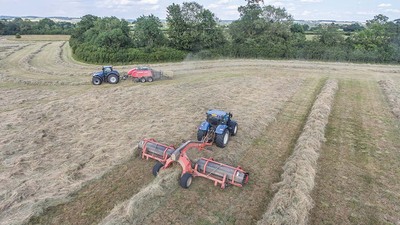
Kuhn Merge Maxx 950 offers flexible swath merging solutions, to create large rows for balers and foragers.
"I ordered the merger in 2018 as soon as I saw it," he says. "I thought it was just what we needed to improve forage quality, by gently lifting the crop off the mown stubbles and placing it into a much larger row."
The Merge Maxx 950 uses two, four metre belts, instead of its predecessor's three. It offers two working widths; 7.5m and 9.5m. In its 7.5m setting, the two belts are butted together and afford left- or right-side swath positioning. It can be useful to double-up, by placing two 7.5m rows side-by side on adjacent passes, putting 15 metres, plus the width of the swath, into one row.
Moving to the wider 9.5m setting creates a 1.5m opening between the two belts. In this mode, belts can be operated to merge the swath into a central position. Further flexibility comes from running the belts in the same direction or in opposite directions, enabling a swath to be placed on either side of the machine, or delivering one side swath and one central swath.
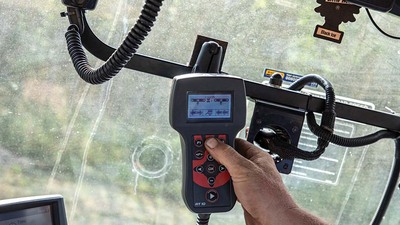
In-cab controls are basic; swath belt speed is changed manually, using flow control valves.
Carried on the tractor's lower link arms, and fitted with its own self-contained hydraulic system, this model is equipped with manual flow control of the two hydraulically driven pickups.
With several thousand acres now under its belt, and having been put to work in grass, hay and straw, its operational flexibility is said to be vast. In grass silage, its operation is considered faultless, making the most of David Hunt's 600hp New Holland FR9060 self-propelled forager.
"Swath presentation is everything, and the merger is giving us a far better swath," he says. "A lumpy swath affects both forager output and chop length. If we can create a consistently dense, wide, and evenly filled swath to load the forager's 3m pickup, we can make the most of output.
"It has worked really well in late season grass and let us pull four rows into one with ease. It just does not knock the stuffing out of grass like a rake can do," he says. "And the less you have to handle the grass, the better the end result."
Pic 5
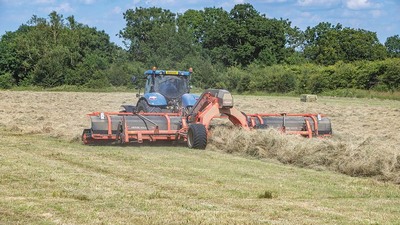
Swath belts can deliver left- or right-side swath positioning, or use a 1.5m opening between the two belts for central swath position.
Used on a New Holland T7.245, the smallest tractor in the fleet, Mr Hunt says the Merge Maxx has so far proved a useful, if not a faultless, investment. An in-field trial against his own GA9531 9m rake showed just how swath construction can boost forager output.
With half the field merged, and the other half raked, performance from the 600hp FR9060 varied considerably. Chopping a 9m raked row, the firm saw a 5.5kph forward speed and 65 per cent engine power utilisation; in the same size merged row, forward speed was easily increased to 10kph, and engine power utilisation reached 90 per cent.
Merger operator Chris Townsend is pleased with the unit, but the differing crop volumes and moisture content has thrown up some headaches during the season.
He says; "It performs better in some crops than others. In loose, dry hay - mostly meadow grass - we have experienced crop dragging on the end of the pickup that is still running through the tedded crop.
"If material was perhaps wetter, and heavier, it would be more likely to separate and less likely to drag."
Pic 6
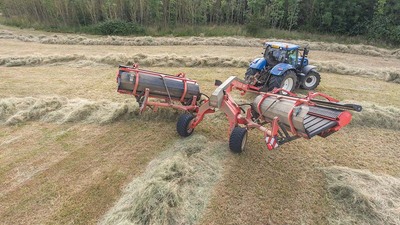
Pickup belts swing rearwards when raised, reducing the overall width for headland turns.
This tangling of tedded meadow grass is still to be addressed by the French maker, which is seeking a method of dividing the crop to prevent it from being dragged by the end of the merger. "That said, with everything else, we have been getting some great, lump-free rows in grass," he adds. "And our trailer drivers have noticed the lack of stones hitting the trailers from the forager chute.
"There are a lot of variables with a merger, which makes it more of an operator's machine compared to a rake, where you could get away with just putting anyone on it, and running at a steady forward speed."
And Mr Hunt agrees. "It is one of those units where an operator needs to spend time in the cab to learn and understand how to get the best from it," he says. "And it also needs consideration for what is following, to decide just how much grass is merged into one swath.
"The Merger has left stones on the ground, and we have extended blade life with the forager this season too," he says.
However, the switch to high capacity merging has also come at a price. "I could have easily bought a pair of twin-rotor rakes for the cost of the Merge Maxx," says Mr Hunt. "So there has to be benefits from making this level of investment that not only suits us, but also our customers."
Merger specifications
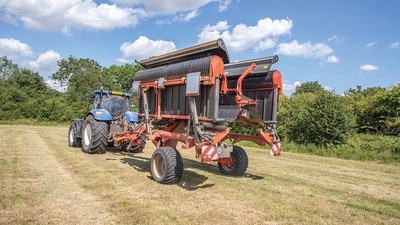
- Model: Kuhn Merge Maxx 950
- Working width: 7.5-9.5m
- Swath capability: Central, split, side-shift
- Minimum power requirement: 85hp
- Transport width: 3m
- Belt drive: Hydrostatic
- List price: from £72,468













